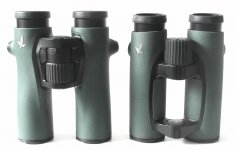Henry,
Im sure your expertise with binoculars far exceeds mine. Ive owned a few pairs, over the past 50 years and confess, I bought what seemed best at the time and just used them to look at stuff. It is my impression from past reads you are one of those who agrees that glare is a thing in some Swarovski binocular models. My own year long, experience, with an EL 1042, and brief look through several other Swaros to include an SLC 1042, EL832, and NL842, puts me in the other camp. I get controversy exists.
I used the EL10s often enough, out and about, in proximity to the open water of San Francisco Bay, with the sun in various states of display do to weather, date, and time of day, to see all kinds of glare... out there, with my naked eye. Aware of the controversy here, I made an effort to see what others report. I remember one day specifically when I was absolutely defeated by glare. The combination of sun angle and wind rippled water was blinding to my naked eye. Curiously through my binocular, it was better. Are folks saying some binos do even better, maybe eliminate this kind of glare? I cannot report seeing glare as an apparent product within my binocular during other less obvious lighting conditions. I should qualify. I wear eyeglasses with conventional bifocals, and have Cataracts....
I quickly acknowledge I have no place to deny what you or others see. I am trying to learn, if hopefully not so much that you teach me to see things I do not now want to see! It seems possible glare as you experience it, is something I actually experience, but just am not experienced enough to know it.
Reading what you wrote above, in #7, I've some questions. It seems you went to a Swarovski dealer, aware they had an NL 832 that you could examine. Armed with the Questar eyepiece, you proceeded to peer inside and look for what are thought to be the causes of glare. Seeing some shiny bits here and there, you concluded these NL832s could indeed produce glare, perhaps similar to what Holger reported.
You wrote,
The best glare performance comes just before the eye starts to experience kidney beaning from being too close to the eye lens.
Did you have a chance to take these outside and look through them at things with existing light condition? Was there light conditions that enabled glare that you could minimize via adjusting the eyepieces as described?
As well,
I would expect slightly worse behavior from the 8x32 than the 8x42 overall because of its less effective baffling and its smaller exit pupil,
Trying to understand, maybe Ive even read this elsewhere, why does the smaller exit pupil of the 32 OL make things worse? In fact might it be the opposite as the smaller EP is dealing with a narrower band of light and the glare causing artifacts within may be causing scattered light that is wider/beyond the width of the EP? To try and imagine what you describe, is it a function of the location of the shiny bits suspected of causing reflections that turn into glare? Some do, some don't, depending. If those are here and there, can one predict their contribution, greater or lesser, to glare?









